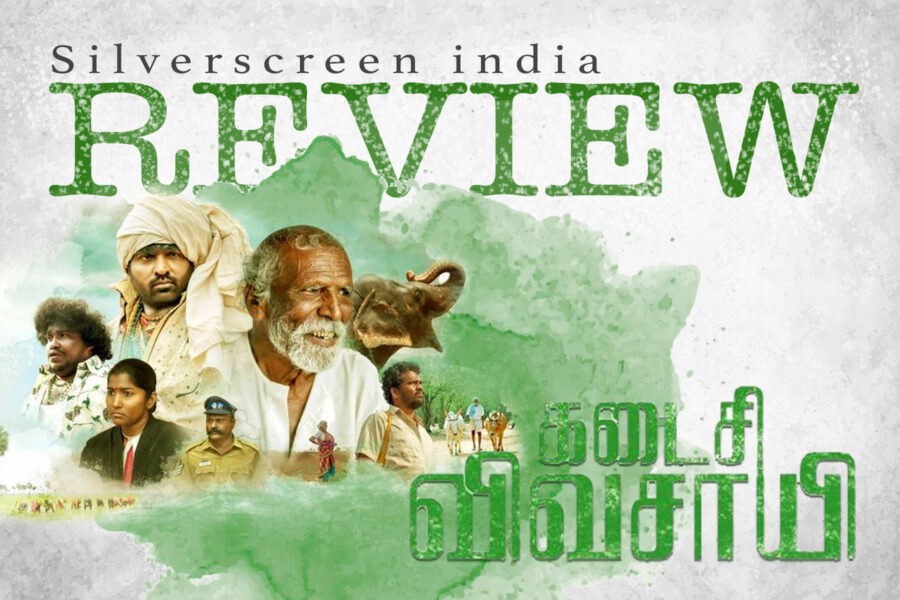For his fourth film, director M Manikandan has gone back to his roots. Kadaisi Vivasayi is set around his own hometown near Usilampatti. It follows the titular kadaisi vivasayi (last farmer) of a small village, the octogenarian Maayandi. The self-sufficient old farmer lives alone and takes care of his two bulls and some chicken. After a lightning strike burns down an ancient tree, the village folk decide they have to hold a kovil thiruvizha (temple festival) and pray to their kulasaami (ancestral god) to lift the perceived curse. And an important part of this festival is the offering of new grain grown specifically for the purpose. Maayandi being the only farmer left in the village – everyone else having sold their land and moved on to other means of living – it falls on him to cultivate his small plot of land. While he’s in the middle of this process, Maayandi finds himself detained for a crime he did not commit and others are forced to try and pitch in for him.
Manikandan takes his time to set the scene. He eases us into this universe, slowly introducing us to its people, its customs, its way of life. The unhurried pace at the start of the film demands our patience but we are well rewarded. By the time the conflict is introduced around the halfway mark, we are completely immersed in the world and invested in the story. It is not often we get a Tamil film that trusts the audience like this one. A director who is unafraid to hold frames, especially ones where not much is happening, without worrying we will lose interest (Manikandan is also the cinematographer of Kadaisi Vivasayi). So this is a rare treat.
And then there’s the wonderful cast – largely made up of non-actors, who could easily give many that call themselves actors a run for their money. Late real-life farmer Nallandi has played Maayandi so brilliantly, anyone who sees this film will have a hard time getting his careworn face out of their mind for a long while. The only known actors here are Vijay Sethupathi and Yogi Babu. Sethupathi plays a character who intersects with the story only slightly. His Ramaiya adds a touch of magic to the film. And though his arc feels like a tangent, it helps illustrate the people of the village and is given closure. Babu’s role, on the other hand, feels extraneous and the actor sticks out a bit. I wonder if any of his portions got chopped off because he really seems wasted from what I saw in the theatrical cut.
For all the film gets right, it is not without certain other issues as well. They say every movie tells us a lot about the filmmaker behind it. With Kadaisi Vivasayi, we don’t have to look too deep to find out what Manikandan believes. His disapproval of hybrid seeds and the use of chemical pesticides, and that he generally bemoans the move away from old-school farming methods and idealises a life away from modern conveniences – this is all present right at the surface in unambiguous dialogues and situations. This kind of traditionalist thinking, while it may seem harmless and even reasonable to some, is not without its problems. I will admit, however, that almost all of these views are woven very organically into the narrative. For instance, the preparations for the festival make the younger people in the village realise how little they know about the old ways – not just farming but traditional art like pottery too is dying out, the film shows us.
Manikandan also gives us a rather rosy picture of village life in Kadaisi Vivasayi. He shows snatches of brawls over caste and then resolves it rather easily. There are no bad guys in this film. Except for the system. I was particularly struck though by how unjust our justice system is. The magistrate (played by an excellent Raichal Rabecca) is convinced Maayandi is innocent almost right away, it is all but proved he committed no crime, and yet he ends up spending far too long in detention. Only because that’s how the system works. And it simply cannot be hurried. This also hits hard since we live in times when dissidents are increasingly often, and all too easily, trapped in this justice system for unbelievably long periods. Manikandan treats this with irony – Maayandi cannot comprehend what is happening to him – and that only makes the injustice of it strike us more forcefully.
Recommended
But Kadaisi Vivasayi is not out to make us feel bad or sad. It is ultimately a celebration, like the festival it culminates in. The film’s opening credits play over scenes of rural life and there are many shots of all kinds of non-human life too. We realise why we were shown this when we come to understand how Maayandi views the world and all life in it. Those scenes of nature are also a reminder to us to savour our world. That’s something this film makes us do as well – for 2 hours it makes us slow down and engage with something beautiful – and that’s a very precious thing.
*****
This Kadaisi Vivasayi review is a Silverscreen original article. It was not paid for or commissioned by anyone associated with the movie. Silverscreen.in and its writers do not have any commercial relationship with movies that are reviewed on the site.



